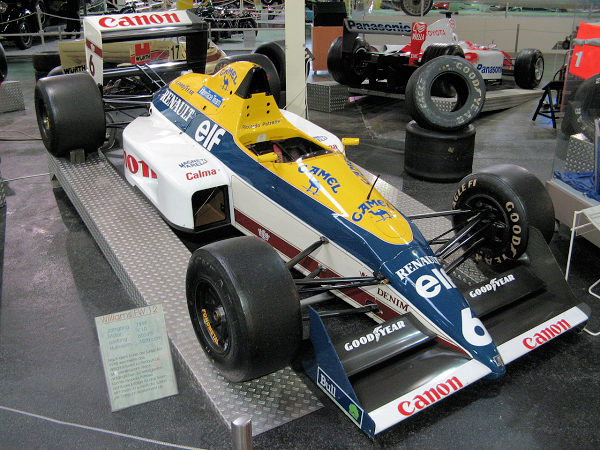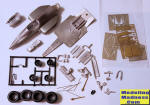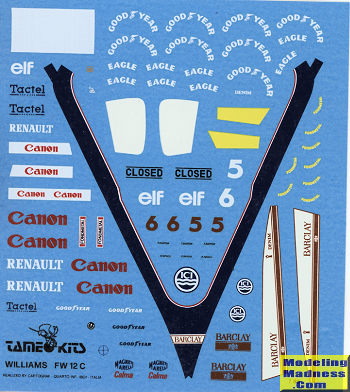
Tameo 1/43 Williams-Renault FW 12C
| KIT #: | TMK 94 |
| PRICE: | $30.00 'used' |
| DECALS: | Two options |
| REVIEWER: | Scott Van Aken |
| NOTES: | Cast metal multi-media kit |

| HISTORY |
During the 1988 season, Williams worked with their new engine supplier Renault to develop their new the RS1 3.5 V10 engine. Williams designed a test mule for the engine named FW12B, very much like the Judd-powered car Williams used for the 1988 season except the mule was designed to accommodate the extra length of a V10 engine and not a V8 like the race cars used. For the 1989 season the Renault V10 engine was used. This was the first Renault powered Williams F1 car and also saw Renault's re-entry into Formula One after stopping the supply of their turbocharged engines following the 1986 season. The updated and revised FW12C showed its potential in the season opening Brazilian Grand Prix with Patrese qualifying 2nd and leading the race from the start in what was his 176th Grand Prix start, which was then a record. Patrese also set the fastest lap of the race before retiring in front of the pits with a broken harmonic balancer.
During this time the car scored its only win when Thierry Boutsen (who had replaced Mansell in the team) scored his first win at the rain affected Canadian Grand Prix, and with Patrese finishing second it was Williams's first 1–2 result since the 1987 Mexican Grand Prix. Patrese, who had his best season to date after consecutive 2nd-place finishes in Mexico, Phoenix and Canada, followed by a 3rd in France, also scored the car's only pole position at the Hungarian Grand Prix. He then comfortably led the race until lap 54 when a hole in the radiator caused the car to overheat into retirement.
By the time of the Italian Grand Prix at Monza, it had become obvious that the limit of the FW12C had been reached, with the team starting to fall behind both McLaren, with their Honda V10 engine, and Ferrari with their V12, while also being consistently challenged by Benetton and the Cosworth built Ford V8 of which they had exclusive use. Williams, who had decided to continue with the car, preferring to get its successor, the FW13, right before making its race debut, decided after Italy, where Boutsen finished 3rd with Patrese 4th, that the FW12C would be retired and the new car introduced for Portugal. The main reason for the late appearance of the FW13 was that it had originally been designed for Williams' active suspension system and it had to be re-designed and tested with normal or 'passive' suspension with Patrick Head deciding to iron the bugs out before debuting the car. Patrese then preferred to go back to the FW12C for the Spanish Grand Prix, finishing 5th in the last Formula One race for the car.
| THE KIT |
 Typical
of F1 kits in any scale, this one is race specific, being the one raced at
the San Marino GP. This was the second race of the 1989 season and actually
held on the track at Imola, Italy as San Marino is too small a country to
have room for a racing track. The reason these kits are race specific is
that there are often small changes to the car as well as different
placements of some of the sponsor logos. This kit has markings for two cars
as driven by each of the drivers for that year; Thierry Boutson and Riccardo
Patrese.
Typical
of F1 kits in any scale, this one is race specific, being the one raced at
the San Marino GP. This was the second race of the 1989 season and actually
held on the track at Imola, Italy as San Marino is too small a country to
have room for a racing track. The reason these kits are race specific is
that there are often small changes to the car as well as different
placements of some of the sponsor logos. This kit has markings for two cars
as driven by each of the drivers for that year; Thierry Boutson and Riccardo
Patrese.  Cast
metal is used for the upper body, chassis pan, front and rear wing airfoils
as well as mirrors and some other smaller bits including the pieces that
hold the rear axle stubs in place. The fron wheel attachment points are also
the disc brake pieces.
Cast
metal is used for the upper body, chassis pan, front and rear wing airfoils
as well as mirrors and some other smaller bits including the pieces that
hold the rear axle stubs in place. The fron wheel attachment points are also
the disc brake pieces. | CONCLUSIONS |
Most 1/43 kits today are nearly all resin, but 'back then', cast metal was the material of choice. I've built quite a few of these older kits and they are really not as difficult as one might think. They just take a bit of time and care to produce a superb replica.
| REFERENCES |
https://en.wikipedia.org/wiki/Williams_FW12
June 2018 Copyright Modelingmadness.com. All rights reserved.
If you would like your product reviewed fairly and fairly quickly, please contact the editor or see other details in the Note to Contributors.
Back to the Main Page Back to the Review Index Page Back to the Previews Index Page